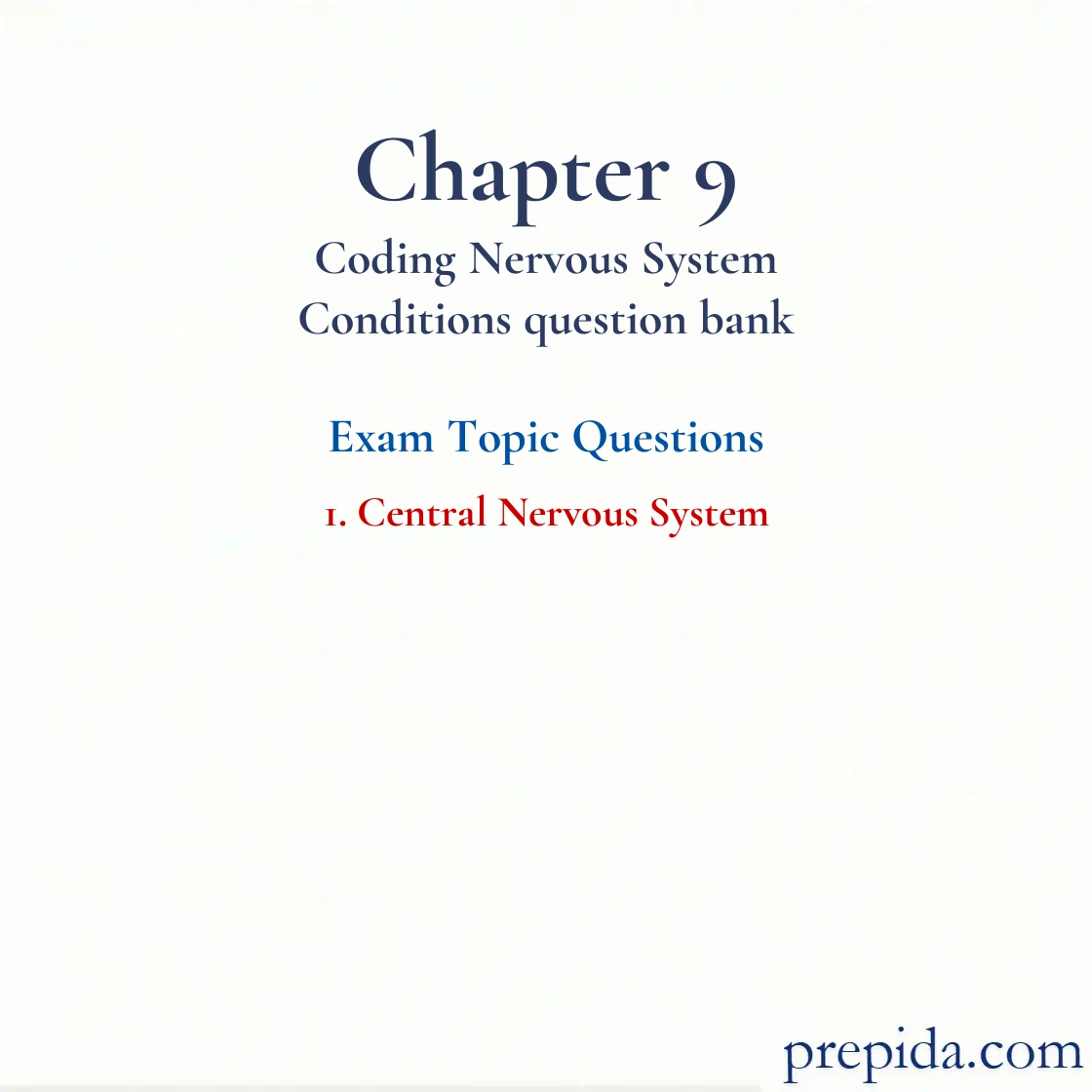
Which of the following codes are assigned for an adult patient with progressive spinal muscle atrophy and anxiety?
- G12.20, F41.8
- G12.21, F41.9
- G12.22, F41.8
- G12.29, F41.9
The correct codes for a patient diagnosed with progressive spinal muscle atrophy in an adult and anxiety are G12.21 and F41.9. G12.21: Index>atrophy>muscle>progressive>spinal>adult. F41.9: Index>anxiety.
Sign: Objective evidence of a disease or condition.
What are the correct codes for a patient with primary central sleep apnea and MS?
- G47.30, G35
- G47.31, G35
- G47.32, G35.01
- G47.39, G35.01
The correct codes for a patient with primary central sleep apnea and multiple sclerosis are G47.31 and G35. G47.31: Index>apnea>sleep>primary central. G35: Index>sclerosis>multiple.
Hypertension: High blood pressure, usually a chronic condition; often identified by a systolic blood pressure above 140 mm/Hg and/or a diastolic blood pressure above 90 mm/Hg.
Which of the following are the three protective layers of membrane that insulate the brain?
- Basal ganglia
- Hypothalamus
- Cerebral meninges
- Cerebellum
The cerebral meninges are the three protective layers of membrane that insulate the brain.
hich of the following is not part of the brainstem?
- Midbrain
- Pons
- Cerebral meninges
- Medulla oblongata
The medulla oblongata, pons, and midbrain are all part of the brainstem.
The spinal cord is part of which nervous system?
- Autonomic nervous system
- Central nervous system
- Peripheral nervous system
- None of these
The central nervous system includes the brain and the spinal cord.
Cerebrovascular Accident (CVA): Rupture of a blood vessel in the brain; also known as stroke.
How many layers are in the spinal meninges?
- 2
- 3
- 4
- 5
The spinal meninges have three layers: dura mater, arachnoid mater, and pia mater.
All of the following are layers of the meninges except the:
- arachnoid mater.
- basal mater.
- dura mater.
- pia mater.
The cerebral meninges include the dura mater, arachnoid mater, and pia mater.
In which layer of the meninges is CSF found?
- Arachnoid mater
- Basal mater
- Dura mater
- Pia mater
The arachnoid mater is the center of the meninges and contains CSF.
Which layer of the meninges is the outermost?
- Arachnoid mater
- Basal mater
- Dura mater
- Pia mater
The dura mater is the outermost layer of the meninges.
Anatomical Site: A specific location or part of the human body.
Which layer of the meninges contains a network of nerves and blood vessels?
- Arachnoid mater
- Basal mater
- Dura mater
- Pia mater
The pia mater is the deepest layer, which contains a network of nerves and blood vessels.
Anatomical Site: A specific location or part of the human body.
What is the correct code assigned for progressive bulbar palsy?
- G12.20
- G12.21
- G12.22
- G12.29
The correct code for progressive bulbar palsy is G12.22. G12.22: Index>palsy>bulbar.
Sign: Objective evidence of a disease or condition.
Which of the following controls coordination and maintaining balance?
- Basal ganglia
- Hypothalamus
- Cerebral meninges
- Cerebellum
The cerebellum is the posterior portion of the brain that controls coordination and maintains balance.
Anatomical Site: A specific location or part of the human body.
What are the correct codes assigned for a patient with Fazio-Londe disease and vitamin E and K deficiencies?
- G12.1, E56.8
- G12.1, E56.0, E56.1
- G12.29, E56.0, E56.1
- G12.29, E56.8
The correct codes for Fazio-Londe disease and vitamin E and K deficiencies are G12.1, E56.0, and E56.1. G12.1: Index> Fazio-Londe disease. E56.0: Index>deficiency>vitamin E. E56.1: Index>deficiency>vitamin K.
Sign: Objective evidence of a disease or condition.
Which lobes are responsible for the senses?
- Frontal lobes
- Parietal lobes
- Temporal lobes
- Occipital lobes
The temporal lobes are responsible for the senses.
Which lobes are responsible for interpretation and coordination of sensory information?
- Frontal lobes
- Parietal lobes
- Temporal lobes
- Occipital lobes
The parietal lobes are responsible for interpretation and coordination of sensory information.
Which lobes control speech, critical thinking, and memory?
- Frontal lobes
- Parietal lobes
- Temporal lobes
- Occipital lobes
The frontal lobes are responsible for motor areas including speech, personality, behavior, and intellect.
What is the gray matter of the brain?
- The cerebral cortex
- The cerebrum
- The cerebellum
- The medulla oblongata
The gray matter of the brain is the cerebral cortex.
What is the largest part of the brain?
- The cerebral cortex
- The cerebrum
- The cerebellum
- The medulla oblongata
The largest part of the brain is the cerebrum.
Cerebrovascular Accident (CVA): Rupture of a blood vessel in the brain; also known as stroke.
What is the control headquarters for the entire body?
- The brain
- The cerebrum
- The cerebellum
- The medulla oblongata
The brain is the control headquarters for the entire body.
Cerebrovascular Accident (CVA): Rupture of a blood vessel in the brain; also known as stroke.
Which lobes process visual impulses?
- Frontal lobes
- Parietal lobes
- Temporal lobes
- Occipital lobes
The occipital lobes process visual impulses.
Which of the following controls body temperature and the autonomic nervous system?
- Basal ganglia
- Hypothalamus
- Cerebral meninges
- Cerebellum
The hypothalamus controls body temperature and the autonomic nervous system.